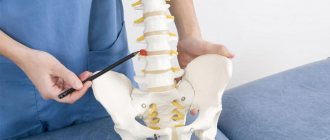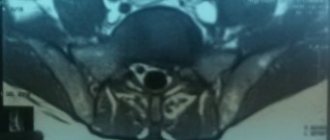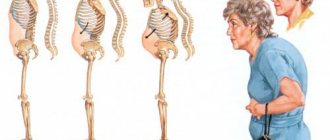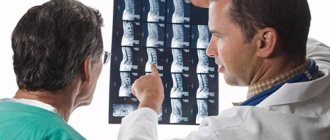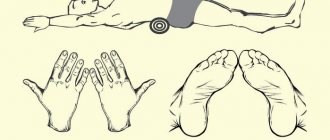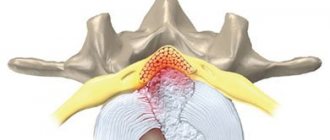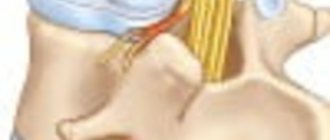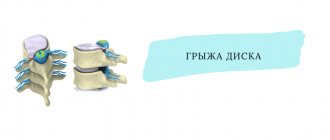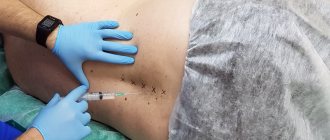It is perhaps impossible to recall a single case in which a proven intervertebral hernia in a patient did not require the use of medications sooner or later. Drug treatment using one or another means for a herniated disc is usually carried out at the initial stage of its occurrence, when the patient is suddenly constrained by severe and acute pain, as well as during periods of its exacerbation. What are the features of treating hernias with medications, and what are these medications needed for?
Cervical hernia on MRI.
Features of the course of the disease
With constant overloads and uneven loads on the spine, the nucleus pulposus softens. It is forced out from the center to the side. If movement occurs as a result of compression, the tissue membrane bulges. Then, when unloading occurs, the core returns to its previous position.
At the first stages of such a pathological process, the membrane is capable of recovery. After a certain period of time, if nothing changes, the recovery of the shell slows down. In this case, the disease begins to develop more actively, an intervertebral hernia is formed with accompanying symptoms.
The clinical picture of a hernia is determined by the stage of its development and localization. In some cases, there is more than one such formation. The more nerve bundles, ligaments and muscles are involved in degenerative processes, the more intense the symptoms.
There are certain stages of development of intervertebral hernia:
- Prolapse. At this stage, the disc moves no more than 3 millimeters.
- Protrusion. At this stage, the disc has shifted by more than 4 millimeters, but it has not yet gone beyond the fixing ring.
- Extrusion. The fibrous capsule loosens and the nucleus protrudes from it.
- Sequestration. The ring breaks, the core protrudes completely outside of it.
The direction of the hernia can be different. If its formation occurs on the front or side of the disc, damage to surrounding structures does not occur. When a hernia forms in the back, nerve bundles are compressed and soft tissue is damaged. With timely treatment, it is possible to stop the progression of the disease.
At the initial stage of development, there are no symptoms. Sometimes minor pain or discomfort may be felt in the area where the protrusion develops. As the disease progresses, pain occurs and becomes more intense over time. With the simultaneous development of several hernias, the clinical picture is layered and becomes pronounced.
Characteristic signs of the development of the disease include:
- Pain syndrome. Pain is a key sign of formation formation. At first, the painful sensations are mild and go away on their own. As the pathological process develops, the pain does not go away even if the person is at rest. Most often the pain is aching. It is often accompanied by numbness of the limbs, paresthesia or loss of sensation.
- Muscle tension. When pain appears, a person instinctively tries to spare the sore spot and begins to limit physical activity. This creates muscle tension, which can lead to a misalignment of the spinal column. In the future, in this situation, the discs are injured.
Symptoms may appear depending on the location of the formation.
For a cervical hernia:
- fingers go numb;
- attacks of dizziness occur;
- attacks of headaches appear;
- nausea or even vomiting appears;
- blood pressure surges;
- pain in the neck, shoulder girdle, and upper limbs.
For thoracic hernias:
- discomfort in the chest;
- difficult to swallow;
- when sneezing or coughing, the pain becomes stronger;
- there is pain similar to an angina attack, and pain in the stomach also appears;
- dyspeptic phenomena.
Most often, hernias of the lumbar spine are formed. They are accompanied by the following symptoms:
- pain in the lumbar region;
- toes become numb, muscle tone decreases;
- some reflexes are lost;
- there are difficulties with bowel or bladder function;
- difficulty walking.
How to prevent pain?
In order not only to remove, but to prevent the appearance of pain, you simply need to prevent the appearance of a hernia. Simple rules must be followed:
- move correctly and work on your posture, avoid flat feet;
- carry weights only evenly in a backpack on your back;
- when lifting weights, try to hold the load symmetrically, and in no case on one shoulder or in one hand;
- do not bend or turn while carrying a heavy load;
- monitor body weight, avoiding its excess;
- regularly try to hang on the horizontal bar or swim, unloading the spine, and do therapeutic exercises;
- after reaching a certain age, check the level of calcium in the blood, prevent osteoporosis;
- in winter, and especially in the presence of ice, you need to refrain from sudden movements, since falls and injuries are a risk factor for protrusion and hernia.
This way you can avoid severe back pain. If you already have a protrusion, or, moreover, a hernia, and they bother you regularly, then the best way is a modern minimally invasive surgical intervention.
Currently, they are being carried out with great success in Bulgaria, the Czech Republic, and including Russia. These are cold plasma and laser nucleoplasty, vaporization, endoscopic microdiscectomy. As a result, either the appearance of a hernia from the protrusion is prevented, or the cartilaginous protrusion itself is eliminated, and the nerve roots, muscles and ligaments no longer compress anything. Only surgery can lead to radical extraction and improve the quality of life.
Principles of conservative therapy
Conservative treatment of lumbar spinal hernia without surgery involves the use of complexes that will help restore paravertebral tissues and intervertebral discs. The main goal of conservative therapy is:
- eliminating tension from the muscular system;
- strengthening muscle tissue;
- uniform distribution of load on the spinal column;
- getting rid of the disease without using radical methods.
It is unacceptable to use any means on your own if you have such a diagnosis. This is fraught with the development of complications. You should also not do exercises, since it is difficult to independently calculate the load on the spine. When the first symptoms appear, it is important to consult a doctor in a timely manner, undergo the prescribed diagnostics and strictly follow all medical recommendations. In each specific case, individual therapy is prescribed.
Cooling and warming ointments for the spine
Treatment of lumbar hernia with ointments should be carried out in accordance with the recommendations of the attending physician. Indications for the use of products for external use include:
- pain in the affected area;
- muscle tone:
- pinched nerve endings;
- disruption of natural processes in tissues.
To enhance the effect of ointments, it is necessary to wash the skin with soap before applying the product. And after the skin is covered with the composition, you need to cover this place with a warm (woolen) scarf, thus, the components of the drug are absorbed much faster and penetrate deeper.
Many products have a strong effect on the skin, so they can cause burning, itching or an allergic reaction. If side effects occur, you should contact a medical facility and stop taking the drug.
A doctor who will take into account all the features of the pathology and the patient’s body must select an external remedy for lumbar hernia. Treatment of hernial inflammation should not be limited to the use of ointments.
Irritating gel for cartilage disc prolapse
In folk medicine, gels based on bee and snake venoms are widely used. Their effect has not been clarified by scientists, but it is assumed that the effect is due to irritation of specific reflexogenic zones by biologically active substances.
Among these remedies for vertebral hernia we can recommend:
- Vipratox - contains venoms of several types of snakes in combination with camphor and methyl salicylate. The ointment is rubbed into painful areas in an amount of 5-10 grams 2 times a day;
- Viprosal - contains viper poison in combination with fir oil, camphor, glycerin and salicylic acid. The method of application is similar to vipratox;
- Virapin – purified bee venom for rubbing 2 times daily;
- Apisatron - contains essential and mustard oils mixed with bee venom. Used for daily rubbing in a dose of 2-5 grams.
Bee and snake venoms are often added to warming ointments along with pepper and methyl salicylate. Such agents greatly dilate peripheral vessels at the site of action, therefore increasing heat transfer.
Immediately after a spinal injury, local cooling agents should not be used, but only cooling ones. They usually contain an anticoagulant, analgesic, essential oil and menthol, which soothe and anesthetize the damaged area.
If the injury is fresh, coolants should not be rubbed into the skin. You just need to apply them and wait until the substance is absorbed on its own. For these purposes, it is better to use gels that are quickly absorbed and thus provide an active effect.
Apply the product to a clean area of skin.
It is important to keep the affected area warm. For the best effect, you can additionally wrap the smeared area with a scarf.
The tonic effect of anesthetic ointments precludes their use during sleep. The use of such products is indicated only during the daytime. Do not intensively rub warming ointment into the affected area during exacerbation of osteochondrosis; it is better to apply the product with light movements, without pressure. When osteochondrosis has successfully entered the remission phase and the pain has become aching, it is recommended to use warming ointments in combination with therapeutic massage.
Irritating and cooling ointments for intervertebral hernia are used after receiving an acute spinal injury. They are safe in case of infectious disease and severe inflammation. After application, such ointments relieve pain, eliminate bleeding and soothe the damaged area.
Drug treatment
When the disease worsens, pain becomes intense and movements are limited. In this case, the patient is prescribed drug therapy.
With the help of medications, you can get rid of the clinical signs of the disease and improve the general condition of a person. These drugs include anti-inflammatory, decongestant, hormonal, enzyme, and muscle relaxants. With the help of these drugs you can reduce the severity of symptoms.
It is important to understand that such treatment is effective, but to completely get rid of the disease it is necessary to eliminate the cause of its development. Otherwise, after a certain time, the disease recurs. When undergoing treatment for a lumbar disc herniation without surgery, certain side effects may occur. In parallel, gastroprotectors and hepatoprotectors are prescribed.
Nonsteroidal anti-inflammatory drugs
Most often, such drugs are prescribed for the development of degenerative processes in the joints or spine. Such medications have an analgesic, antipyretic and anti-inflammatory effect, and eliminate pain. The predominant number of drugs that are included in this category are non-selective inhibitors of the cyclooxygenase enzyme. This enzyme is directly involved in the production of mediators of the inflammatory process.
With the help of non-steroidal anti-inflammatory drugs, the inflammatory focus in the area where the intervertebral hernia is located is reduced. Medicines relieve swelling, relieve pinched spinal nerve bundles, relieve pain, and improve motor activity. Most often, selective agents are prescribed in treatment. After taking these medications, there is no negative effect on the mucous membranes of the intestines and stomach. Such drugs include Nimid, Movalis, Celecoxib.
If the above-mentioned drugs do not bring the desired result, doctors prescribe non-steroidal anti-inflammatory drugs of a non-selective group. These include Diclofenac, Dicloberl, Ibuprofen, Ketoprofen. In this case, gastroprotectors are necessarily prescribed - Omez, Zolopent, Nolpazu.
Muscle relaxants
The main task of these drugs is to reduce muscle tone and get rid of contractures. Such drugs include Movalis and Mydocalm.
Glucocorticosteroids
These drugs contain hormonal substances. Long-term use of these drugs should not be prescribed, as they can adversely affect articular cartilage. These medications are used short term.
Biogenic stimulants
To speed up tissue restoration, an aloe extract is used. This drug is given by injection. The medicine Fibs is also used to activate regeneration processes. These drugs are administered every day for one month.
Medicines to improve blood flow
These drugs include Pentoxifylline. With its help, blood microcirculation improves, tissues are better supplied with oxygen. This drug is injected or taken orally.
Enzymes
Hydrolytic enzymes relieve inflammation and improve the body's natural resistance. The drugs relieve swelling and help reduce pain.
Vitamin products
To help the body treat the disease, vitamins A, B1, B6, B12, C, D, E are used. With the help of B vitamins, the intensity of symptoms is reduced, normal tissue sensitivity is restored, and the severity of pain is reduced. These drugs are taken orally or given by injection.
At the same time, vitamin D and calcium are prescribed. They help restore bone density and strengthen ligaments. Vitamin A, tocopherol, ascorbic acid act as antioxidants. They remove free radicals and enhance recovery processes.
Painkillers
Medicines are used to relieve acute inflammation. These include Ibuprofen, Tempalgin, Spazmalgon, Solpadeine.
In the presence of intense pain that cannot be relieved with non-steroidal anti-inflammatory drugs, blockades using Novocaine, Lidocaine, Kenalog, Celeston, Metipred are prescribed. Such drugs help to quickly get rid of acute pain and stop the source of inflammation.
Chondroprotectors
In the presence of an intervertebral hernia, destruction of the nucleus pulposus occurs. It cannot recover on its own. The patient is prescribed chondroprotectors. With the help of these drugs, metabolic processes in the tissues of the spine are improved. They are a good prevention of the formation of hernias and the development of diseases of the musculoskeletal system. Such medicines include: Dona, Artra, Chondroitin, Chondrolon, Elbona. Such drugs are taken for up to six months, then take a break of one month and repeat the course of treatment.
What is not treated for exacerbation of protrusions and hernias
It should be immediately clarified that in the Russian Federation there is no way to treat even very severe acute back pain caused by a hernia with narcotic analgesics, for example, by applying the Durogesic patch. What is used in developed countries, such as the USA, Great Britain, Israel, and the Czech Republic, where hernia treatment is carried out according to modern standards and with great efficiency, is practically impossible in Russia. A doctor who prescribes Durogesic for a hernia, at the very least, risks being left without a position, and, in extreme cases, attracting the close attention of the relevant authorities.
It is also not customary to treat intervertebral hernias with drugs called antispasmodics. For example, Baralgin or No-shpa will be ineffective because they relax mainly the smooth muscles of the internal organs and have nothing to do with the back muscles, although they relieve pain from spasms in gallstone disease.
It is useless to “treat” an intervertebral hernia with analgin and other ancient drugs. Aspirin, all types of acetylsalicylic acid, and paracetamol will have no effect on pain. Their job is to lower the temperature. By the way, during exacerbation of osteochondrosis and the appearance of back pain due to protrusions and hernias, there is never an increase in temperature.
If fever occurs against the background of back pain, then this may be a serious sign of exacerbation of pyelonephritis, the presence of atypical forms of cholecystitis and appendicitis with irradiation to the back, and other serious diseases.
Protrusions and hernias are not treated using various angioprotectors, such as pentoxifylline, trental and others. Their task is to improve capillary microcirculation in diseases such as diabetes, Raynaud's syndrome, and so on. Since intervertebral cartilage is generally devoid of any vessels, it makes no sense to use them. But it makes no sense to improve microcirculation in spasmed muscles, since first the muscle spasm should be relieved (using muscle relaxants), and then the muscle can cope on its own without additional means.
Various “drips” or intravenous infusions are not indicated: after all, the primary task is to relieve inflammation and remove swelling, and adding fluid to the body prevents this and can only increase the pain. The most effective medications are those from the group of NSAIDs and muscle relaxants. True, in some cases, on the first day of acute back pain, you can additionally relieve swelling by prescribing mild diuretics that will not harm the heart and retain potassium in the body. So, the patient can be prescribed spironolactone (or Veroshpiron) for one or two days for this purpose.
Manual therapy
One of the most effective methods of preventing the formation of intervertebral hernia is manual therapy. This is a combination of effects on soft tissues along with correction of the articular apparatus. In this case, blood circulation and motor activity of the spine are restored. It is recommended to combine manual therapy with spinal traction and the Cypress exercise machine.
During the procedure, the chiropractor warms up the muscles in the desired area. Next, he applies gentle pressure, trying to eliminate the displacement of the disc, release the pinched nerve, and eliminate pain. In each specific case the approach is individual.
During the first therapy sessions, the specialist gently stretches the spine. The result is the release of the pinched nerve bundle, and as a result the pain becomes less pronounced. Further therapy sessions help restore damaged cartilage and muscle tissue.
Results of manual therapy sessions:
- improvement of blood microcirculation in tissues;
- improving the nutrition of cartilage tissues and oxygen access to them;
- returning the intervertebral disc to the desired position;
- reducing the intensity of pain;
- relief from increased muscle tone and spasm;
- return of normal mobility of vertebral structures.
This method is universal in the treatment of hernia. It is effective if drug therapy does not bring the desired results. By regularly taking a course of manual therapy, you can prevent the development of complications of the disease, restore joint mobility, and get rid of unpleasant symptoms of the disease.
Muscle relaxants
These are remedies that relax muscles in case of pain due to a lumbar hernia. The drugs relieve the spasm and the pain goes away on its own. Additionally, muscle relaxants improve blood circulation and metabolism in tissues.
Muscle relaxants are often prescribed along with NSAIDs to better relieve pain and reduce the risk of side effects.
The most effective muscle relaxants for spinal hernia:
Baklosan ( Baclofen ). The product quickly relieves spasms and painful sensations. The price of tablets is from 150 rubles.
Baklosan
Mydocalm . It is considered the most popular drug. The drug additionally relieves pain and nervous tension. Does not cause drowsiness. The cost of tablets is from 150 rubles, solution for injections – from 420 rubles.
Sirdalud . Relieves pain in affected areas of the back and improves muscle function. The price of tablets is from 150 rubles.
Sirdalud
Clonazepam : tablets – from 100 rub.
Tizanidine . The product is well tolerated by patients and does not interfere with the gastrointestinal tract. The price of tablets is from 100 rubles.
Sibazon : tablets - from 20 rubles, solution for injections - from 20 rubles.
Muscle relaxants are prescribed only by the attending physician due to serious side effects that lead to disruption of the nervous system. An overdose of drugs can lead to the death of the patient.
Physiotherapy
With the help of therapeutic exercises, the muscular frame of the back is strengthened and the lumbar region is stabilized. The classes include exercises that are selected by the doctor individually in each case. With the help of regular training, you can prevent surgery and restore mobility.
Often, doctors prescribe a course of therapy, which includes conservative and physical therapy, as well as massage. Therapeutic exercises are an additional method of rehabilitation. If performed regularly, further development of the disease and complications can be prevented.
The result of regular exercise is:
- improvement of blood microcirculation;
- elimination of spasm;
- eliminating clamps on nerve bundles;
- improving access to oxygen and active drug preparations;
- restore mobility.
Physiotherapy
Physiotherapeutic procedures are effective. They are used to quickly restore lost body functions. The impact occurs through waves, rays, pressure, water.
Physiotherapy is used for the following purposes:
- reduce the severity of pain in the area where the inflammatory process develops;
- improve blood microcirculation;
- reduce the intensity of the processes of destruction of cartilage and bones;
- eliminate swelling;
- speed up metabolic processes.
The treatment algorithm is drawn up by the doctor after preliminary diagnosis. There are different types of physiotherapeutic procedures that will bring good results after completing the prescribed course:
- laser treatment;
- magnetic therapy;
- pressotherapy;
- electrophoresis;
- EHF;
- UHF;
- ultrasound;
- reflexology;
- exposure to heat;
- massage;
- radon baths;
- balneotherapy;
- ozokerite;
- paraffin therapy.
Magnetotherapy
It is a modern type of physiotherapeutic treatment. The impact occurs due to a static magnetic field. It can be constant or pulsed. Using this procedure, you can get rid of pain, reduce swelling, and restore damaged tissue.
EHF
The procedure involves exposure to high-frequency current. This is a targeted stimulation, which results in improved blood microcirculation, elimination of edema, and slowdown of inflammatory processes.
Electrophoresis
Electrophoresis is the most popular method. Involves exposure to low-frequency current pulses. Under its influence, active substances of drugs penetrate deeply into damaged tissues.
Ultrasound
The result of completing the course is the regeneration of damaged cells and relief from pain. Metabolic processes are also activated.
Paraffin therapy
The procedure improves blood circulation. It relieves swelling and reduces the severity of the inflammatory process.
Radon baths
Such procedures are carried out mainly in sanatoriums. Surgery is a contraindication.
Acupuncture
The procedure is a traditional oriental practice. It involves influencing biologically active points of the body.
Electrical stimulation
The procedure involves exposure to low-frequency pulsed currents. With the help of this procedure, the severity of symptoms is reduced and the cause of the disease is eliminated.
Results after completing the course of procedures:
- improved blood circulation;
- prevention of further tissue destruction;
- breakdown of salt deposits;
- getting rid of clamps on nerve bundles;
- improvement of nerve conduction;
- relief from pain.
Currents Bernard
Electrodes are introduced with further impulses. After the procedure, tissue nutrition is restored, degenerative processes are inhibited, and pain is eliminated.
Shock wave therapy
This therapy helps get rid of pain and swelling, and increases the rate of tissue restoration. After completing the course, vasodilation occurs, blood flow is activated, and swelling is eliminated.
Before undergoing procedures, it is necessary to perform a diagnosis. The therapy complex is prescribed only by a doctor.
Annoying
Irritating ointments based on snake and bee venoms are widely used in the treatment of intervertebral hernia.
Mechanism of action
The effect of these drugs is not fully understood. Scientists suggest that the effect of irritating ointments is due to the effect of biologically active substances on specific reflexogenic zones. Snake and bee venoms may be present in warming agents along with methyl salicylate and pepper.
These drugs effectively fight intervertebral hernia. They stimulate natural receptors, which causes blood vessels to dilate and provide more blood flow. Also, irritating ointments increase the rate of metabolic reactions and improve muscle tone in the back area. Thus, the time required for complete recovery is significantly reduced.
The components contained in warming ointments can be hazardous to health. Therefore, such drugs can be used in dosages recommended by a doctor or the manufacturer’s instructions. Also, ointments based on bee and snake venoms cannot be used for liver diseases, tuberculosis, pregnancy and cardiovascular pathologies.
List of drugs
- Capsicam. Absorbed quickly. After applying the drug to the skin, a feeling of burning and warmth occurs. Pain relief lasts up to 6 hours.
- Nicoflex. Penetrates deep into the skin and affects peripheral nerve endings. The active ingredients contained in Nicoflex have a warming effect and dilate blood vessels. The effect occurs quickly. The duration of action is about 1 hour.
Folk remedies
It is important to remember that alternative therapy is not an alternative to conservative treatment, it is only an addition to the main course of treatment.
How to treat a hernia of the lumbar spine with folk remedies:
- Tincture from cinquefoil root. Used internally and externally. To prepare, you need to chop the cinquefoil root and add a liter of vodka or alcohol. Leave for three weeks in a dark, dry place. Next, you need to strain the product. Use for compresses, lotions and applications. It is recommended to combine with Dimexide.
- Comfrey root ointment. Grind the raw materials, add melted pork fat, pour in vodka or alcohol. After hardening, rub into the sore spot.
- A solution of St. John's wort and sunflower oil. Used for lotions and applications.
- The garlic is crushed and filled with alcohol. After 10 days, strain. Use for compresses.
- Kalanchoe pulp is used for compresses.
- Flatbread made of red clay.
- Mumiyo is mixed with honey and used as a compress.
Before using any alternative treatment methods, you should always consult a doctor. Folk remedies are especially effective in the early stages of the disease.
Classification by mode of action
When prescribing products for local application to patients with lumbar hernias, the doctor must take into account the pharmacological effect of the ingredients. For example, in case of inflammation in the vertebral segments, it is prohibited to use drugs with a warming effect. And if the skin is hypersensitive, you should not use products with a local irritating effect.
Warming drugs
After relief of inflammation, patients are recommended to apply warming agents to the lower back to eliminate pain - Turpentine ointment, Viprosal, Apizartron, Nayatox. They contain components that, upon contact with the skin, stimulate blood flow to its surface. There is a pleasant feeling of warmth and sometimes a slight burning sensation.
Warming medications can quickly eliminate stiffness and reduce the intensity of painful sensations. Such products are used 1-2 times a day for 2 weeks or once when discomfort or back pain occurs.
Irritants
Products with a local irritant effect include Capsicam, Finalgon, Efkamon. They contain ingredients that act on subcutaneous tissue receptors. Impulses are generated that enter the central nervous system and block the brain’s perception of painful sensations.
Irritants are used when discomfort occurs in the lower back after hypothermia or excessive physical exertion.
Cooling ointments
In the treatment of hernias, not only cooling pharmacological preparations are used in the treatment, but biologically active additives with phytoextracts of medicinal plants, essential and cosmetic oils. These are ointments and gels that contain camphor or menthol - Bom-Benge, Ben-Gay, some Dikul balms. With the help of these external remedies, you can not only quickly cope with lower back pain, but also eliminate inflammatory swelling. Due to their formation, spinal roots are often pinched.
Traditional medicine for spinal hernia
Folk remedies are used in the treatment of disc displacement only after achieving stable remission with the permission of the attending physician. They are used to prevent exacerbation of pathology.
| Homemade ointments | Recipe |
| Warming | Grind a teaspoon of sea salt with 30 g of petroleum jelly in a mortar. Add 10 g of gum turpentine, 50 g each of butter and baby cream. Mix, transfer to a jar, and store in the refrigerator. Rubbed into the lower back to relieve pain |
| Locally irritating | Mix 50 g of Vaseline and badger fat, add 2 drops of essential oils of juniper, cypress and thyme. Store the ointment in the refrigerator and apply to the lower back when discomfort occurs. |
https://youtube.com/watch?v=XJwFgrwB2Os
